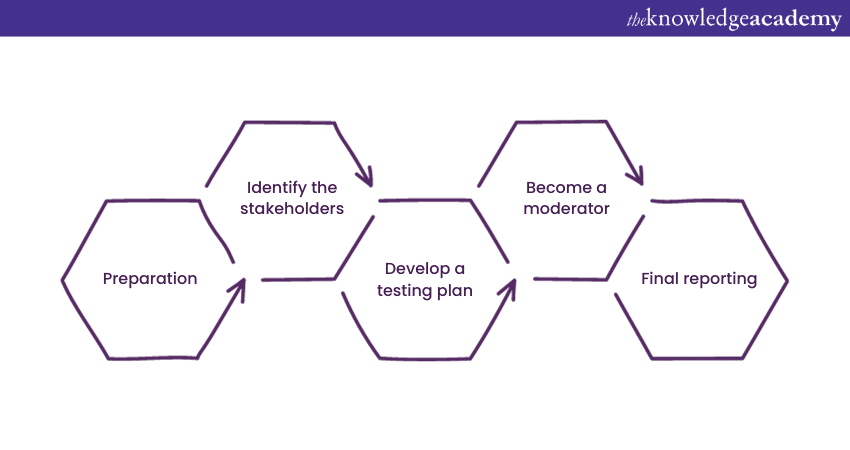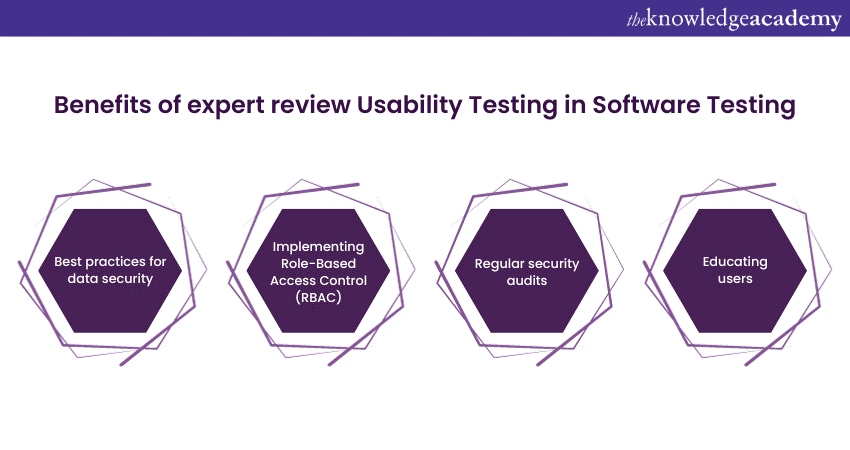We may not have the course you’re looking for. If you enquire or give us a call on +852 2592 5349 and speak to our training experts, we may still be able to help with your training requirements.
Training Outcomes Within Your Budget!
We ensure quality, budget-alignment, and timely delivery by our expert instructors.

Developing a software product that meets the user’s demand with high quality is a challenging task for many organisations. That’s where the Usability Testing in Software Testing comes in. Understanding Usability Testing can help you identify flaws in your design as well as improve the overall user experience of your products.
According to Glassdoor, the average gross salary of a Software Tester in the UK is about £34,563. It is a great job with a decent salary, and if you are interested in pursuing this career, then this blog is for you. In this blog, you will learn What is Usability Testing in Software Testing, its key phases, various methods as well as its benefits. Let’s dive in deeper to learn more!
Table of Contents
1) What is Usability Testing in Software Testing?
2) Phases of Usability Testing in Software Testing
3) Advantages of Usability Testing in Software Testing
4) Various methods of Usability Testing
5) Best Usability Testing Software tools
6) Conclusion
What is Usability Testing in Software Testing?
In this section, you will learn the Usability Testing definition in Software Testing. Before a software product is deployed, it undergoes several tests, and Usability Testing in Software Testing is one of them. It is also known as User Experience (UX) Testing. This testing is used for gauging the level of difficulty when it comes to using a software application. It tests whether an application is easy to use or not. A group of users are usually handpicked to use the software in order to determine the bugs and defects.
There are many benefits to performing this testing. However, it should be done at the earliest stages of product development as it will be difficult to implement proper changes at the late stages. Other than that, performing it at late stages can lead to unnecessary delays in deploying a product.
Importance of Usability Testing in Software Testing
In most cases, Usability Testing in Software Testing is conducted with random users. They can find problems with a product that is previously unknown to the organisation that created the product. This can help the developers and designers optimise the product to make it more aligned with the needs of potential customers.
Phases of Usability Testing in Software Testing?
From preparation to the final reporting, Usability Testing in Software Testing has five different stages. Let’s explore them below:

1) Preparation: The very first stage in Usability Testing in Software Testing is selecting a software product. Once it is selected, you need to prepare it for the testing process. Performing Usability Testing is a complex operation that involves many processes. However, this stage is the most important of all, as if this step is not done properly, it could jeopardise the entire operation.
2) Identify the stakeholders: Usability Testing in Software Testing is considered a closed group testing, which is usually performed with five members. However, this number could vary based on the product you are testing. In this phase, you need to find these participants along with an employee to assist with the testing process.
3) Develop a testing plan: In this phase, you will create a plan for the testing process. The primary objective of creating this plan is to record everything from deciding the way you want to perform the testing and what metrics you want to use, possible challenges you may face and the number of members involved.
4) Become a moderator: During this phase, the moderator plays a pivotal role, and they need to forge an effective partnership with the members involved in the testing. Here, the moderator will observe all of the members' actions and obtain feedback from them without any bias. All of the feedback and other observations will then be documented to make key decisions for future changes.
5) Final reporting: During the final phase, you will present the results of your documentation to the stakeholders. This usually involves the designers, developers, and your clients.
Advantages of Usability Testing in Software Testing
Be it software or a website, they both can benefit a lot from Usability Testing. From the initial development stage to the final product, testing can greatly improve a product throughout its lifecycle. Let’s take a look at some of the benefits of Usability Testing in Software Testing:
1) Evaluate your design: Implement testing at the earliest by bringing in testers to evaluate your prototype. This helps identify any errors before finalising the product design. Test whether it has any bugs and if the product reacts in the same manner as it was designed. Identifying bugs at the earliest stages helps you tweak your product and prevents you from spending valuable time and money.
2) Fulfil client expectations: Testing your website or application will help determine whether your product meets client expectations or not. Gather the feedback from the test group to identify what and where your product is lacking. This will provide a rough idea of how to tweak your product to ensure it fulfils your client's needs.
3) Detect inconsistencies: Other than that, it will provide key information on why your product is not functioning properly. Let's say you want to operate a website and want to find out why your website visitors might leave it early. You can find the reasons with the help of Usability Testing.
4) Increase efficiency: It helps improve the overall efficiency of your product by helping you identify flaws and issues.
Different methods of Usability Testing
There are many methods available for Usability Testing in Software Testing. Let’s explore some of them below:
Paper prototype testing
Paper prototype testing is a conventional method that involves creating testing models using hand-drawn sketches. It is typically done by the project team at the initial stages of testing. There are many benefits to using this method. Let’s take a look at some of them below:

1) Less expensive: It doesn’t require any fancy equipment and all you need is paper and a pencil. So, it is extremely inexpensive to perform this type of testing.
2) Provides clarity: It describes deeply all the possible scenarios and the processes involved. So, it helps you prepare for various scenarios by providing better clarity on how you execute various processes.
3) Identify issues: Since it is done at the initial stages of a project, it helps in detecting issues at the earliest when compared to the other testing processes.
Automated Usability Testing
This method is quite the opposite of the paper prototype technique, as everything is automated. In this process, an organisation will create automation scripts with triggers and conditions. When certain conditions are triggered, the automation program will test the product for bugs and issues. The results of this test will then be automatically recorded and submitted for evaluation.
In order to create the automation scripts, an organisation need to hire an Automation Testing expert if they don’t employ one already and pay a small fee for the service. Although it involves using the services of an expert, it is still not nearly as expensive as the expert review method. Hence, many organisations prefer to use this method to conduct tests on their products and services.
Become a certified professional with our Certified Software Testing Professional (CSTP) Training!
Usability lab testing
The usability lab testing is performed with a group of up to ten participants, along with moderators. This method of testing takes place in a lab-like environment with computers. It is somewhat expensive as you need to hire the participants and rent a lab if you don’t have one already, as well as perform the testing.
Remote Usability Testing
This method is quite similar to the expert review method. The difference, though, is in this process, instead of using experts, you will use random users from various locations. It is also done remotely; hence, it is cost-effective and delivers quick results. These users may report flaws if they stumble upon any through many methods like calls, chats and video conferences. So, it is a very convenient method for both the organisation and the testers.
Hallway Testing
This method of testing involves testing your product or service with random users. These users are not well-trained professionals; hence, their evaluation tends to reflect the opinion of real users without any bias. It also is one of the cheapest methods as you are not involving any professionals or experts. However, the downside is it often fails to detect certain flaws which are otherwise visible to an expert’s eyes.
Boost your career with our Certified Software Testing Manager (CSTM) Training!
Guerilla Testing
The name Guerilla testing may sound strange and unusual, but there’s a good reason for that. In this method, testers go out and ask random users about the prototype they designed. By the end of the testing, the testers offer a gift to the users who participated.
Expert review
As the name implies, this method typically involves using an expert to test your product and obtain feedback in the form of documentation. This can be extremely expensive as hiring the service of experts tends to be expensive. At the same time, this type of testing can be done remotely, so you can expect quick results. Many people often hesitate to use this method due to the higher cost, but it is extremely useful for finding defects which won’t be found in traditional methods. Let’s take a look at some of its benefits:

1) Remote testing: This method is convenient for both the testers as well as the organisation that wants its product to be tested. All they need to do is send their prototype online and not worry about geographical constraints.
2) Saves time: Since the products are usually delivered online, there are no unnecessary hassles like shipping-related delays. Moreover, the results are delivered instantaneously and sometimes take less than a day to report their findings.
3) Detect critical issues: There’s a huge difference when it comes to testing your product with a random person and an expert. Experts can help you find loopholes and critical issues. This can be a crucial advantage if your product deals with sensitive information.
4) Extremely reliable: The findings of this testing will be of higher quality and reliable. Moreover, since everything is documented, it makes it easier to implement proper changes.
Best Usability Testing Software tools
If you are looking to optimise your testing process with minimal manual interventions, then it is best to use Software tools for Usability Testing. Let’s take a look at some of the best Usability Testing Software tools on the market now:
1) UsabilityHub: UsabilityHub is one of the best Usability Testing Software tools and can perform many different types of Usability Testing. It has more than 150,000 testers available who can provide feedback at a small price.
2) Lookback: Lookback is a screen recording platform that is used for understanding the way users interact with their software products. One of its best features is its ability to find how users interact with their applications in real time.
3) Optimal Workshop: Optimal Workshop is a Software Testing Tool which provides features for performing Usability Testing wherein users are asked to complete certain tasks. Based on the results of completing these tasks, you can optimise your product.
4) Userfeel: Userfeel is yet another tool used for performing Usability Testing in Software Testing. It is very similar to Optimal Workshop, which lets your testing team create tasks for users to complete, be it on your website or software application. It will record videos of users completing these tasks, which will then be reviewed by the testing team.
Conclusion
We hope you read and understand Usability Testing in Software Testing. It plays a pivotal role in detecting bugs and improving the overall user experience of your products and services. By Implementing a proper testing approach helps your organisation deliver products that are of higher quality as well as meet the client's needs.
Learn how to master Software Testing with our Software Testing Courses & Training – Sign up now!
Frequently Asked Questions
Upcoming Programming & DevOps Resources Batches & Dates
Date
 Certified Software Testing Professional (CSTP)
Certified Software Testing Professional (CSTP)
Thu 1st Jan 1970







 Top Rated Course
Top Rated Course



 If you wish to make any changes to your course, please
If you wish to make any changes to your course, please


